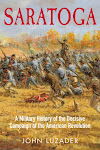Between 20 September and 6 October, General Burgoyne’s troops erected a strong line of field fortifications that included, on the site of much of the fighting of 19 September, the Light Infantry (Balcarres) Redoubt, named for Alexander Lindsay, earl of Balcarres and Crawford, commander of the British Light Infantry, and Fraser’s successor as commander of the Advanced Corps.
By the eve of the second engagement, that redoubt’s western face was about 500 yards long, most of it along a low north-south ridge and incorporating the Freeman Farm buildings. At its southern terminus, the wall turned eastward for 184 yards, then northeastwards for 231 yards. Built of felled trees and earth, with an abbatis of cut trees in front, it averaged about 5 feet high, and along the low ridge 10 to 12 feet.
It mounted 8 cannon and sheltered, after the retreat of Burgoyne’s probing column, at least 1400 men. It was Burgoyne’s strongest post. It was also against that post that Benedict Arnold directed a series of futile attacks after seizing command of Enoch Poor’s Brigade on 7 October. The British continued to occupy it after the fighting ended, withdrawing that night after losing Breymann’s Redoubt during the battle’s final - the subject of next week’s entry. Most of the Americans killed 7 October died in front of the Balcarres Redoubt.
Friday, February 12, 2010
Subscribe to:
Post Comments (Atom)

No comments:
Post a Comment